The Effect of Energy Constraints on Water Allocation Decisions: The Elaboration and Application of a System-Wide Economic-Water-Energy Model (SEWEM)
Abstract
:1. Introduction
2. Novelties and the Design of the SEWEM
2.1. Novelties in the SEWEM
2.2. Selection of the Modeling Approach
2.3. The Model Design
3. The Main Equations of the SEWEM
3.1. Objective Function and Economic Analysis
3.1.1. The Objective Function and Sector-Specific Gross Margins
3.1.2. Sector-Specific Wealth (Revenues) and Production Costs
3.1.3. The Costs of Energy and Water Supply
3.2. Water System
3.2.1. Water Balance at River Node (Reservoir)
3.2.2. Groundwater Balance
3.2.3. Water Supply and Use Relationships at Production Sites
3.3. Energy System
4. Implementation of the Model
4.1. Description of the Study Area and River Network Scheme
4.2. Model Database, Assumptions, Scenarios, and Solutions
4.3. Model Simulation Results
4.4. The Potential Applications, Shortcomings, and Further Fine-Tunings of the SEWEM
5. Summary and Conclusions
Supplementary Materials
Acknowledgments
Author contributions
Conflicts of Interest
Abbreviations
| CES | Constant Elasticity of Substitution |
| CGE | Computable General Equilibrium |
| GBAO | Gorno-Badakhshan Autonomous Oblast |
| KG | Kyrgyzstan |
| KZ | Kazakhstan |
| MOPEC | Multi-Objective Programming with Equilibrium Constraints |
| RRP | Regions of the Republican subordination |
| SDG | Sustainable Development Goals |
| SEWEM | system-wide economic-water-energy model |
| TJ | Tajikistan |
| UZ | Uzbekistan |
References
- Von Braun, J.; Swaminathan, M.S.; Rosegrant, M.W. Agriculture, Food Security, Nutrition and the Millennium Development Goals; International Food Policy Research Institute (IFPRI): New York, NY, USA, 2003. [Google Scholar]
- Rijsberman, F.R. Water Scarcity: Fact or fiction? Agric. Water Manag. 2006, 80, 5–22. [Google Scholar] [CrossRef]
- Alcamo, J.; Florke, M.; Marker, M. Future long-term changes in global water resources driven by socio-economic and climatic changes. Hydrol. Sci. J. 2007, 52, 247–275. [Google Scholar] [CrossRef]
- Rosegrant, M.W.; Ringler, C.; Zhu, T. Water for agriculture: Maintaining food security under growing scarcity. Ann. Rev. Environ. Res. 2009, 34, 205–222. [Google Scholar] [CrossRef]
- Ringler, C.; Bhaduri, A.; Lawford, R. The Nexus across Water, Energy, Land and Food (WELF): Potential for Improved Resource Use Efficiency? Curr. Opin. Environ. Sustain. 2013, 5, 617–624. [Google Scholar] [CrossRef]
- Howells, M.; Hermann, S.; Welsch, M.; Bazilian, M.; Segerstroem, R.; Alfstad, T.; Gielen, D.; Rogner, H.; Fisher, G.; van Velthuizen, H.; et al. Integrated analysis of climate change, land-use, energy and water strategies. Nat. Clim. Chang. 2013, 3, 621–626. [Google Scholar] [CrossRef]
- Mancosu, N.; Snyder, R.L.; Kyriakakis, G.; Spano, D. Water Scarcity and Future Challenges for Food Production. Water 2015, 7, 975–992. [Google Scholar] [CrossRef]
- United Nations (UN) Transforming Our World: the 2030 Agenda for Sustainable Development (A/RES/70/1), 2015. Available online: http://www.un.org/ga/search/view_doc.asp?symbol=A/RES/70/1&Lang=E (accessed on 5 February 2016).
- McCornick, P.G.; Awulachew, S.B.; Abebe, M. Water-food-energy-environment synergies and tradeoffs: Major issues and case studies. Water Policy 2008, 10, 23–36. [Google Scholar] [CrossRef]
- Bazilian, M.; Rogner, H.; Howells, M.; Hermann, S.; Arent, D.; Gielen, D.; Steduto, P.; Mueller, A.; Komor, P.; Tol, R.S.J.; et al. Considering the energy, water and food nexus: Towards an integrated modelling approach. Energy Policy 2011, 39, 7896–7906. [Google Scholar] [CrossRef]
- Young, R.A. Determining the Economic Value of Water: Concepts and Methods; Resources for the Future: Washington, DC, USA, 2005. [Google Scholar]
- Harou, J.J.; Pulido-Velazquez, M.; Rosenberg, D.E.; Medellin-Azuara, J.; Lund, J.R.; Howitt, R.E. Hydro-economic models: Concepts, design, applications and future prospects. J. Hydrol. 2009, 375, 627–643. [Google Scholar] [CrossRef]
- Booker, J.F.; Howitt, R.E.; Michelson, A.M.; Young, R.A. Economics and the modeling of water resources and policies. Nat. Resour. Model. 2012, 25, 168–218. [Google Scholar] [CrossRef]
- Brown, C.M.; Lund, J.R.; Cai, X.; Reed, P.M.; Zagona, E.A.; Ostfeld, A.; Hall, J.; Characklis, G.W.; Yu, W.; Brekke, L. The future of water resources systems analysis: Toward a scientific framework for sustainable water management. Water Resour. Res. 2015, 51, 1–15. [Google Scholar]
- Bekchanov, M.; Sood, A.; Jeuland, M. Review of Hydro-Economic Models to Address River Basin Management Problems: Structure, Applications and Research Gaps; IWMI Working Paper 167; International Water Management Institute (IWMI): Colombo, Sri Lanka, 2015. [Google Scholar]
- Ringler, C.; Bhaduri, A.; Lawford, R. The Nexus across Water, Energy, Land and Food (WELF): Potential for Improved Resource Use Efficiency? Curr. Opin. Environ. Sustain. 2013, 5, 617–624. [Google Scholar] [CrossRef]
- Strzepek, K.M.; Gary, W.Y.; Tol, R.S.J.; Rosegrant, M.W. The value of the high Aswan Dam to the Egyptian economy. Ecol. Econ. 2008, 66, 117–126. [Google Scholar] [CrossRef]
- Bekchanov, M.; Ringler, C.; Bhaduri, A.; Jeuland, M. How would the Rogun Dam affect water and energy scarcity in Central Asia? Water Int. 2015, 40. [Google Scholar] [CrossRef]
- Eshchanov, B.R.; Stultjes, M.G.P.; Salaev, S.K.; Eshchanov, R.A. Rogun Dam—Path to Energy Independence or Security Threat? Sustainability 2011, 3, 1573–1592. [Google Scholar] [CrossRef]
- Daher, B.T.; Mohtar, R.H. Water-energy-food (WEF) Nexus Tool 2.0: Guiding integrative resource planning and decision-making. Water Int. 2015, 40. [Google Scholar] [CrossRef]
- Heaps, C. Integrated Energy-Environment Modelling and LEAP; SEI-Boston and Tellus Institute: Boston, MA, USA, 2002. [Google Scholar]
- International Energy Agency (IEA). World Energy Model—Methodology and Assumptions; World Energy Outlook 2007; IEA: Paris, France, 2007. [Google Scholar]
- Rosegrant, M.W.; Ringler, C.; McKinney, D.C.; Cai, X.; Keller, A.; Donoso, G. Integrated economic-hydrologic water modeling at the basin scale: The Maipo river basin. Agric. Econ. 2000, 24, 33–46. [Google Scholar]
- Ringler, C.; Von Braun, J.; Rosegrant, M.W. Water policy analysis for the Mekong River Basin. Water Int. 2004, 29, 30–42. [Google Scholar] [CrossRef]
- Ringler, C.; Huy, N.V.; Msangi, S. Water allocation policy modeling for the Dong Nai River Basin: An integrated perspective. J. Am. Water Resour. Assoc. 2006, 42, 1465–1482. [Google Scholar] [CrossRef]
- Cai, X.; Rosegrant, M.W. Irrigation technology choices under hydrologic uncertainty: A case study from Maipo River Basin, Chile. Water Resour. Res. 2004, 40, W04103. [Google Scholar] [CrossRef]
- Bekchanov, M.; Ringler, C.; Bhaduri, A.; Jeuland, M. Optimizing Irrigation Efficiency Improvements in the Aral Sea Basin. Water Resour. Econ. 2016, 13, 30–45. [Google Scholar] [CrossRef]
- Cai, X.; McKinney, D.C.; Rosegrant, M.W. Sustainability analysis for irrigation water management in the Aral Sea region. Agric. Syst. 2003, 76, 1043–1066. [Google Scholar] [CrossRef]
- Lofgren, H.; Harris, R.L.; Robinson, S. A Standard Computable General Equilibrium (CGE) Model in GAMS; Discussion Paper No. 75; International Food Policy Research Institute (IFPRI), Trade and Macroeconomics Division (TMD): Washington, DC, USA, 2002. [Google Scholar]
- Böhringer, C.; Löschel, A. Computable general equilibrium models for sustainability impact assessment: Status quo and prospects. Ecol. Econ. 2006, 60, 49–64. [Google Scholar] [CrossRef]
- Dinar, A. Water and Economy-Wide Policy Interventions. Found. Trends Microecon. 2014, 10, 85–165. [Google Scholar] [CrossRef]
- Berck, P.; Robinson, S.; Goldman, G. The use of computable general equilibrium models to assess water policies. In The Economics and Management of Water and Drainage in Agriculture; Dinar, A., Zilberman, D., Eds.; Kluwer Academic Publishers: Boston, MA, USA, 1991. [Google Scholar]
- Lennox, J.A.; Diukanova, O. Modelling regional general equilibrium effects and irrigation in Canterbury. Water Policy 2011, 13, 250–264. [Google Scholar] [CrossRef]
- Keller, A.; Keller, J. Effective Efficiency: A Water Use Efficiency Concept for Allocating Freshwater Resources; Water Resources and Irrigation Division (Discussion Paper 22); Center for Economic Policy Studies, Winrock International: Arlington, VA, USA, 1995. [Google Scholar]
- Cai, X.; Ringler, C.; Rosegrant, M.W. Modeling Water Resources Management at the Basin Level: Methodology and Application to the Maipo River Basin; IFPRI Research Report 146; International Food Policy Research Institute (IFPRI): Washington, DC, USA, 2006. [Google Scholar]
- Doorenbos, J.; Kassam, A.H. Yield Response to Water; FAO Irrigation and Drainage Paper No. 33; Food and Agricultural Organization (FAO): Rome, Italy, 1979. [Google Scholar]
- Micklin, P. The past, present, and future of the Aral Sea. Lakes Reserv. Res. Manag. 2010, 15, 193–213. [Google Scholar] [CrossRef]
- Bekchanov, M. Efficient Water Allocation and Water Conservation Modeling. Ph.D. Thesis, Bonn University, Bonn, Germany, 2014. [Google Scholar]
- Spoor, M. Transition to market economies in former Soviet Central Asia: Dependency, cotton and water. Eur. J. Dev. Res. 1993, 5, 142–148. [Google Scholar] [CrossRef]
- Rudenko, I.; Lamers, J.P.A. The Aral Sea: An ecological disaster. Case study 8-6. In Food Policy for Developing Countries: Case Studies; Pinstrup-Andersen, P., Cheng, F., Eds.; Cornell University: Ithaca, NY, USA, 2010. [Google Scholar]
- Martius, C.; Froebrich, J.; Nuppenau, E.-A. Water resource management for improving environmental security and rural livelihoods in the irrigated Amu Darya lowlands. In Facing Global Environmental Change: Environmental, Human, Energy, Food, Health and Water Security Concepts; Brauch, H.G., Oswald Spring, U., Grin, J., Mesjasz, C., Kameri-Mbote, P., Behera, N.C., Chourou, B., Krummenacher, H., Eds.; Hexagon Series on Human and Environmental Security and Peace; Springer: Heidelberg, Germany, 2009. [Google Scholar]
- O’Hara, S. Central Asia’s water resources: Contemporary and future management issues. Water Resour. Dev. 2000, 16, 423–441. [Google Scholar] [CrossRef]
- Wegerich, K. Handing over the Sunset: External Factors Influencing the Establishment of Water User Associations in Uzbekistan: Evidence from Khorezm Province; Cuvillier Verlag: Göttingen, Germany, 2010. [Google Scholar]
- Bekchanov, M.; Bhaduri, A.; Ringler, C. Potential gains from water rights trading in the Aral Sea Basin. Agric. Water Manag. 2015, 152, 41–56. [Google Scholar] [CrossRef]
- Bekchanov, M.; Ringler, C.; Bhaduri, A. A water rights trading approach to increasing inflows to the Aral Sea. Land Degrad. Dev. 2015. [Google Scholar] [CrossRef]
- Rakhmatullaev, S.; Huneau, F.; Le Coustumer, P.; Motelica-Heino, M. Sustainable irrigated agricultural production of countries in economic transition: Challenges and Opportunities (A case study of Uzbekistan, Central Asia). In Agricultural Production; Felix, C.W., Ed.; Nova Science Publishers: New York, NY, USA, 2010; pp. 139–161. [Google Scholar]
- Rakhmatullaev, S.; Huneau, F.; Kazbekov, J.; Le Coustumer, P.; Jumanov, J.; El Oifi, B.; Motelica-Heino, M.; Hrkal, Z. Groundwater resources and management in the Amu Darya River Basin (Central Asia). Environ. Earth Sci. 2009, 59, 1183–1193. [Google Scholar] [CrossRef]
- Rakhmatullaev, S.; Abdullaev, I. Central Asian irrigation sector in a climate change context: Some reflections. J. Water Clim. Chang. 2014, 5, 341–356. [Google Scholar] [CrossRef]
- Dukhovny, V.A.; de Schutter, J.L.G. Water in Central Asia: Past, Present, Future; Taylor and Francis: London, UK, 2011. [Google Scholar]
- Wegerich, K.; Olsson, O.; Froebrich, J. Reliving the past in a changed environment: hydropower ambitions, opportunities and constraints in Tajikistan. Energy Policy 2007, 35, 3815–3825. [Google Scholar] [CrossRef]
- Rakhmatullaev, S.; Huneau, F.; Le Coustumer, P.; Motelica-Heino, M.; Bakiev, M. Facts and perspectives of water reservoirs in Central Asia: A special focus on Uzbekistan. Water 2010, 2, 307–320. [Google Scholar] [CrossRef]
- Varis, O. Curb vast water use in Central Asia. Nature 2014, 514, 27–29. [Google Scholar] [CrossRef] [PubMed]
- Scientific-Information Center of Interstate Comission of Water Coordination in the Aral Sea Basin (SIC-ICWC). Data on Crop Production Costs and Benefits Collected from Different SIC-ICWC Reports. Unpublished work. 2008. [Google Scholar]
- SIC-ICWC. CAREWIB (Central Asian Regional Water Information Base), 2011. Available online: www.cawater-info.net (accessed on 27 January 2012).
- The European Commission Technical Assistance the Commonwealth of Independent States (EC-TACIS). Formulation & Analysis of Regional Strategies on Land and Water Resources; WARMAP Project Report; EC-TACIS: Tashkent, Uzbekistan, 1997. [Google Scholar]
- Cai, X. Modeling Framework for Sustainable Water Resources Management. Ph.D. Dissertation, University of Texas at Austin, Austin, TX, USA, 1999. [Google Scholar]
- SIC-ICWC. Ways of Water Conservation: Results of WUFMAS Sub-Project, WARMAP-2 Project (TACIS) and Sub Component A-2 of GEF Project “Water Resources and Environment Management in the Aral Sea Basin”; SIC-ICWC: Tashkent, Uzbekistan, 2002. [Google Scholar]
- Schieder, T. Analysis of Water Use and Crop Allocation for the Khorezm Region in Uzbekistan Using an Integrated Hydrologic-Economic Model. Ph.D. Thesis, Bonn University, Bonn, Germany, 2011. [Google Scholar]
- SIC-ICWC. The Database of the Aral Sea Basin Optimization Model (ASBOM); Excel File; SIC-ICWC: Tashkent, Uzbekistan, 2003. [Google Scholar]
- Executive Committee of International Fund for Saving the Aral Sea (EC IFAS). The Aral Sea Basin Economic Allocation Model BEAM, 2013. Available online: www.ec-ifas.org (accessed on 20 August 2013).
- Center for Economic Research (CER). Alternative Energy Source: Potentials for Development in Uzbekistan; CER: Tashkent, Uzbekistan, 2011. [Google Scholar]
- Fields, D.; Kochnakyan, A.; Stuggins, G.; Besant-Jones, J. Tajikistan’s Winter Energy Crisis: Electricity Supply and Demand Alternatives; The World Bank: Washington, DC, USA, 2012. [Google Scholar]
- Britz, W.; Ferris, M.; Kuhn, A. Modeling water allocating institutions based on Multiple Optimization Problems with Equilibrium Constraints. Environ. Model. Softw. 2013, 46, 196–207. [Google Scholar] [CrossRef]
- Kuhn, A.; Britz, W.; Willy, D.K.; van Oel, P. Simulating the viability of water institutions under volatile rainfall conditions—The case of the Lake Naivasha Basin. Environ. Model. Softw. 2016, 75, 373–387. [Google Scholar] [CrossRef]
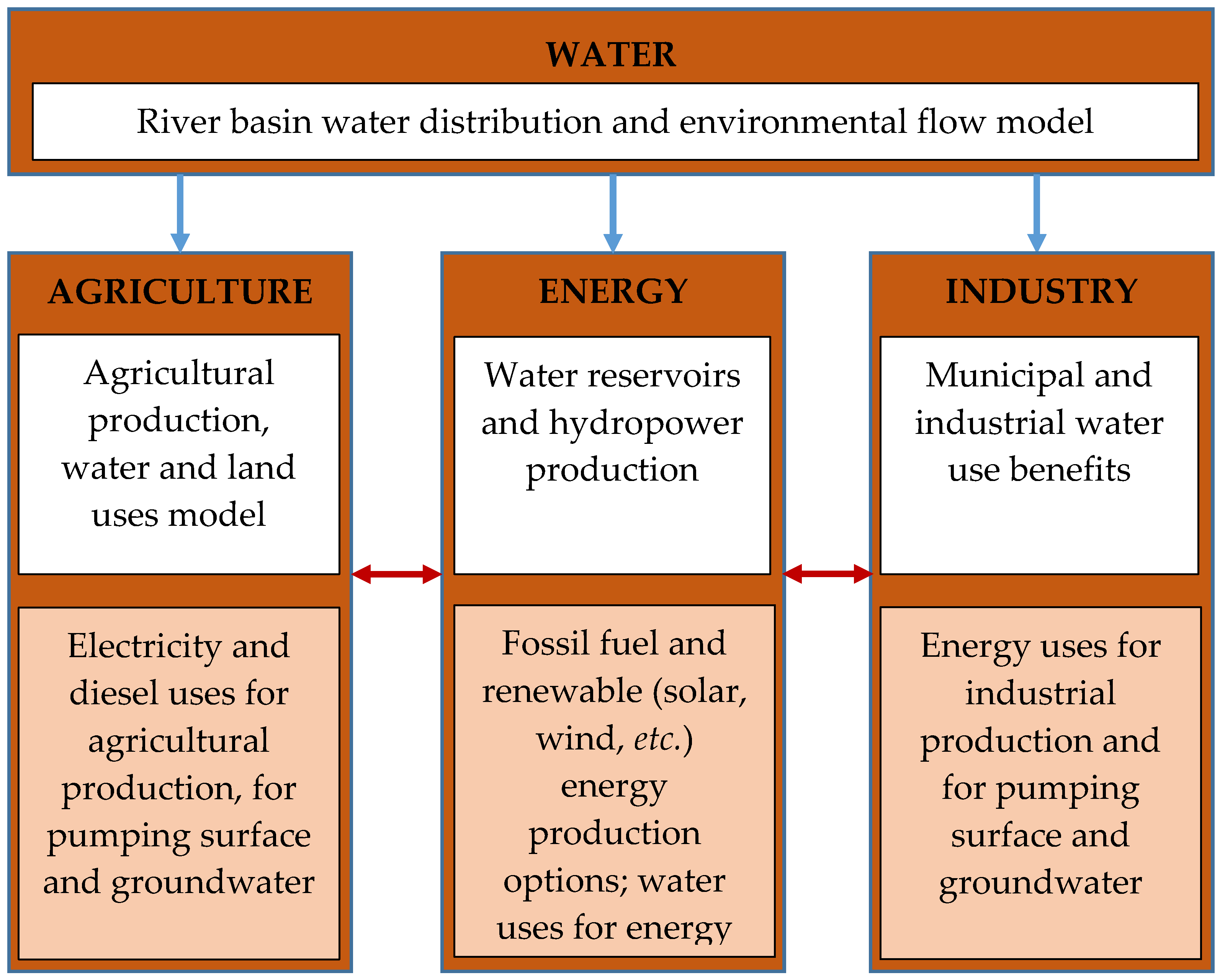
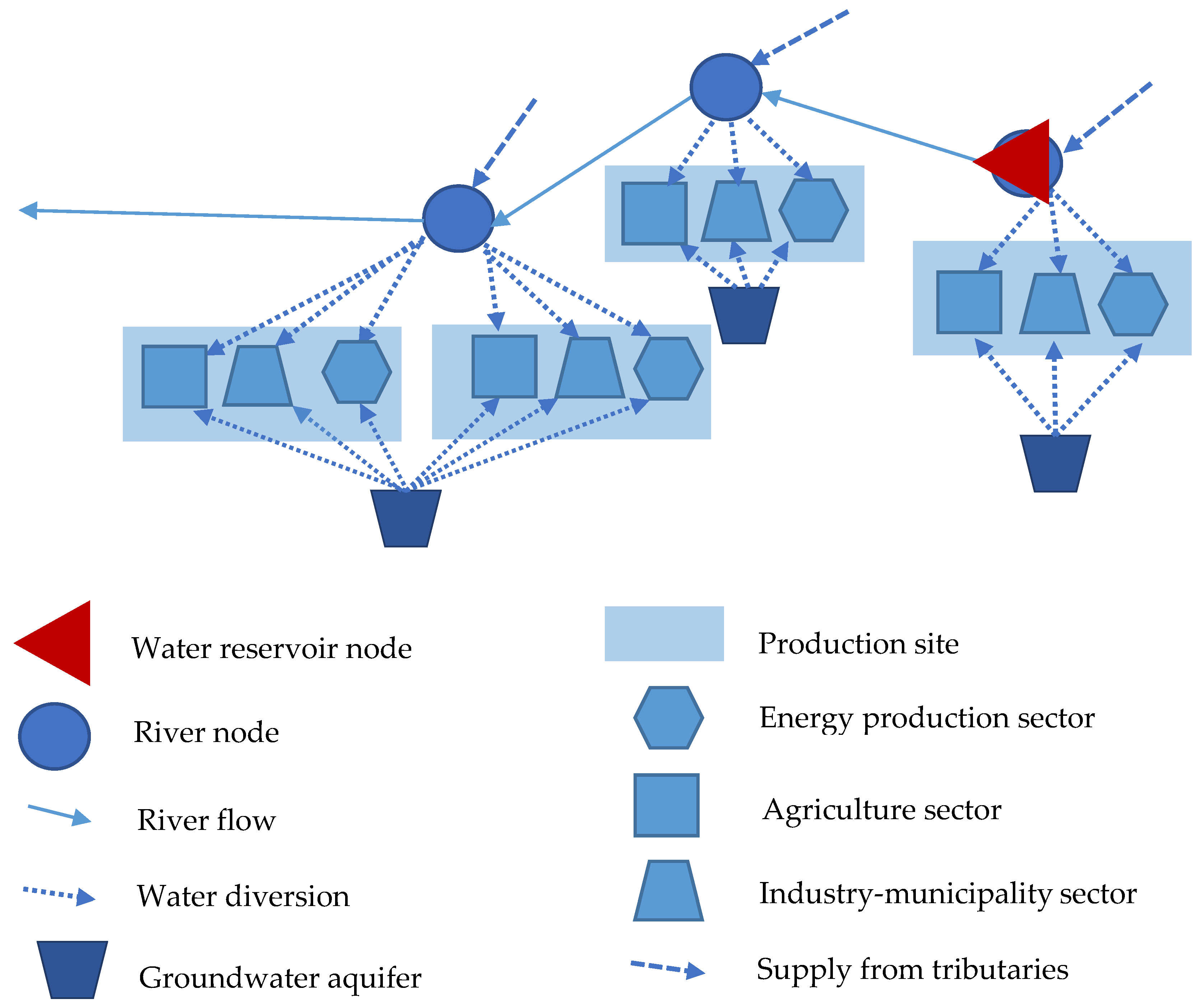
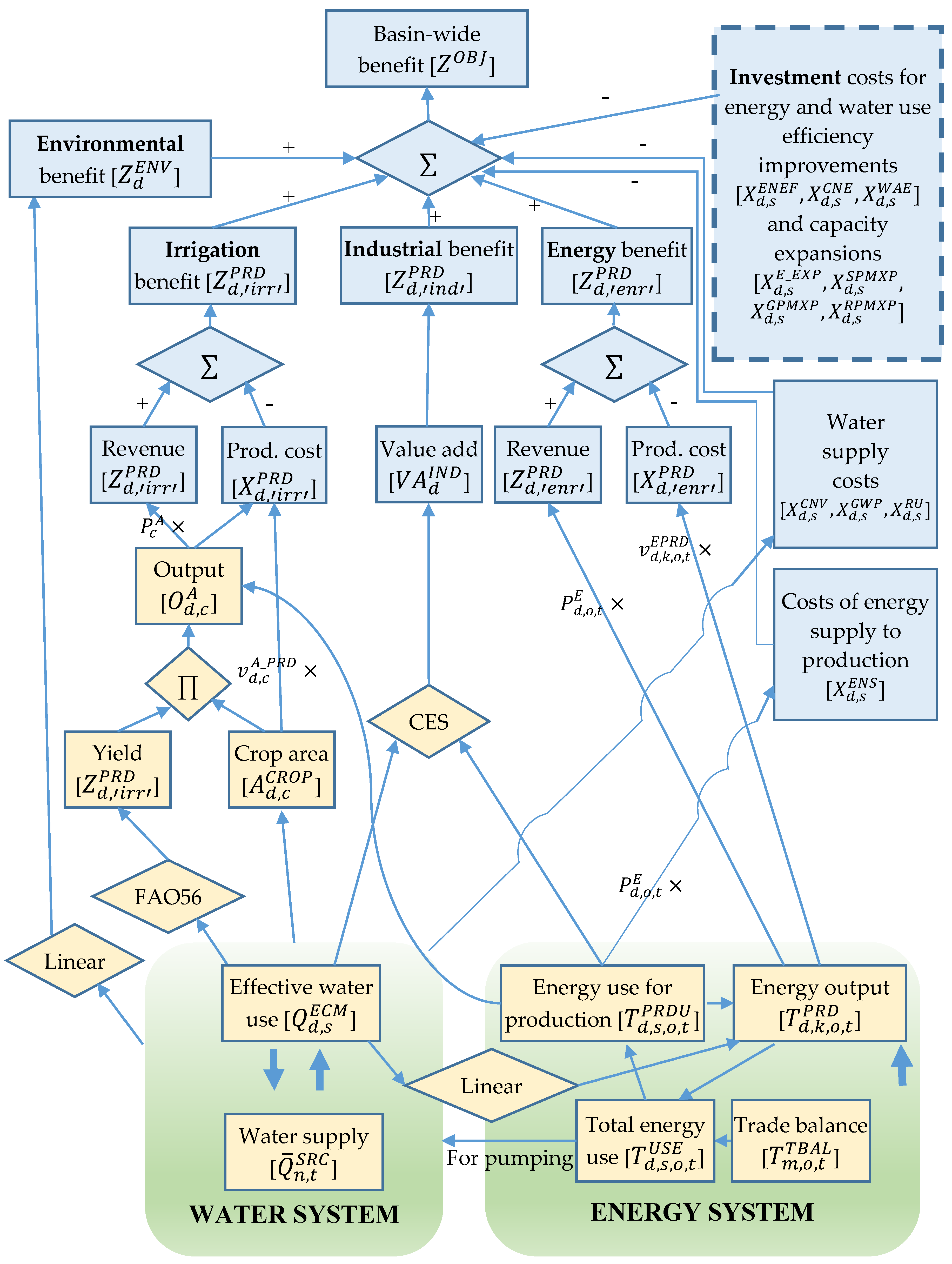
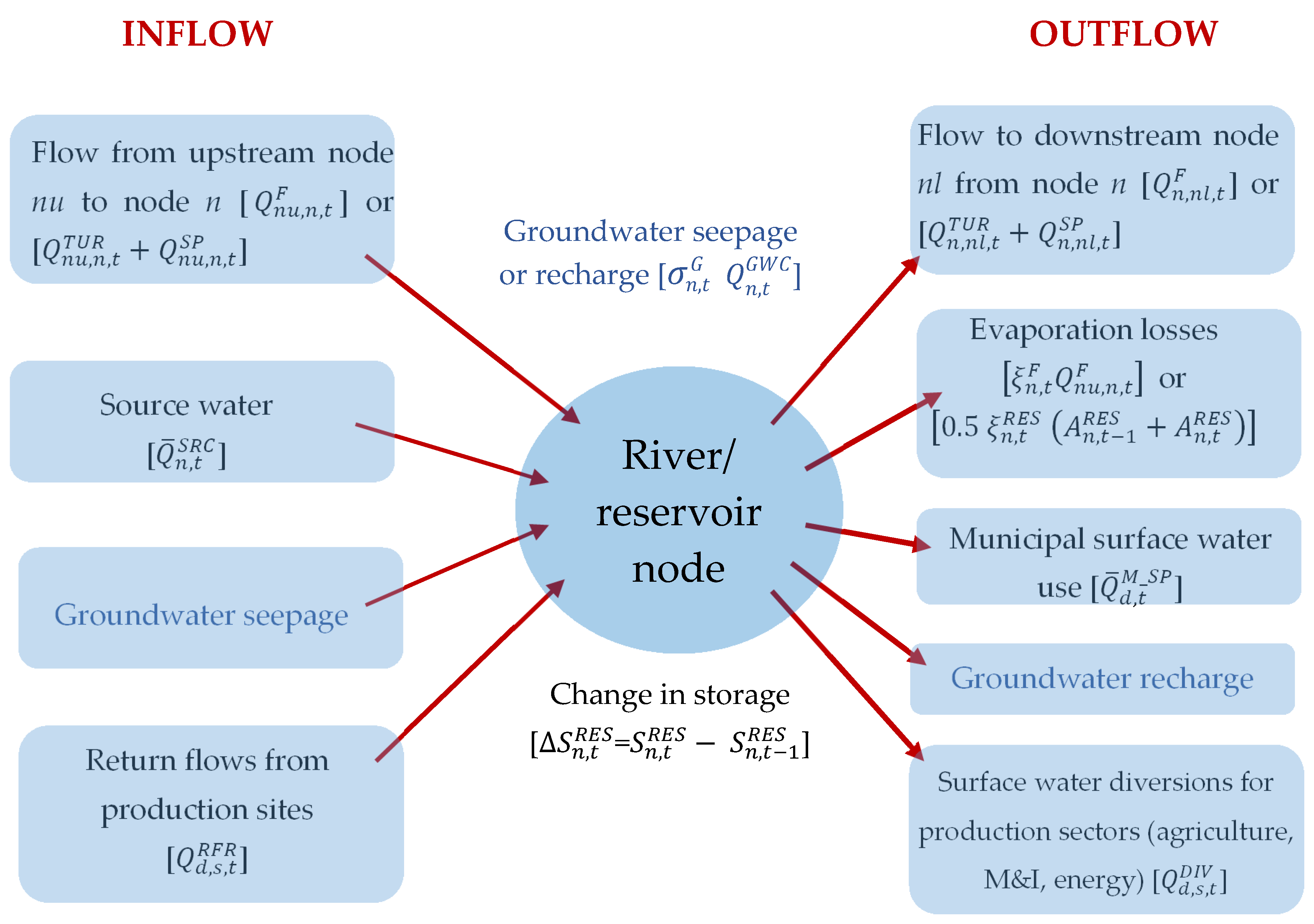
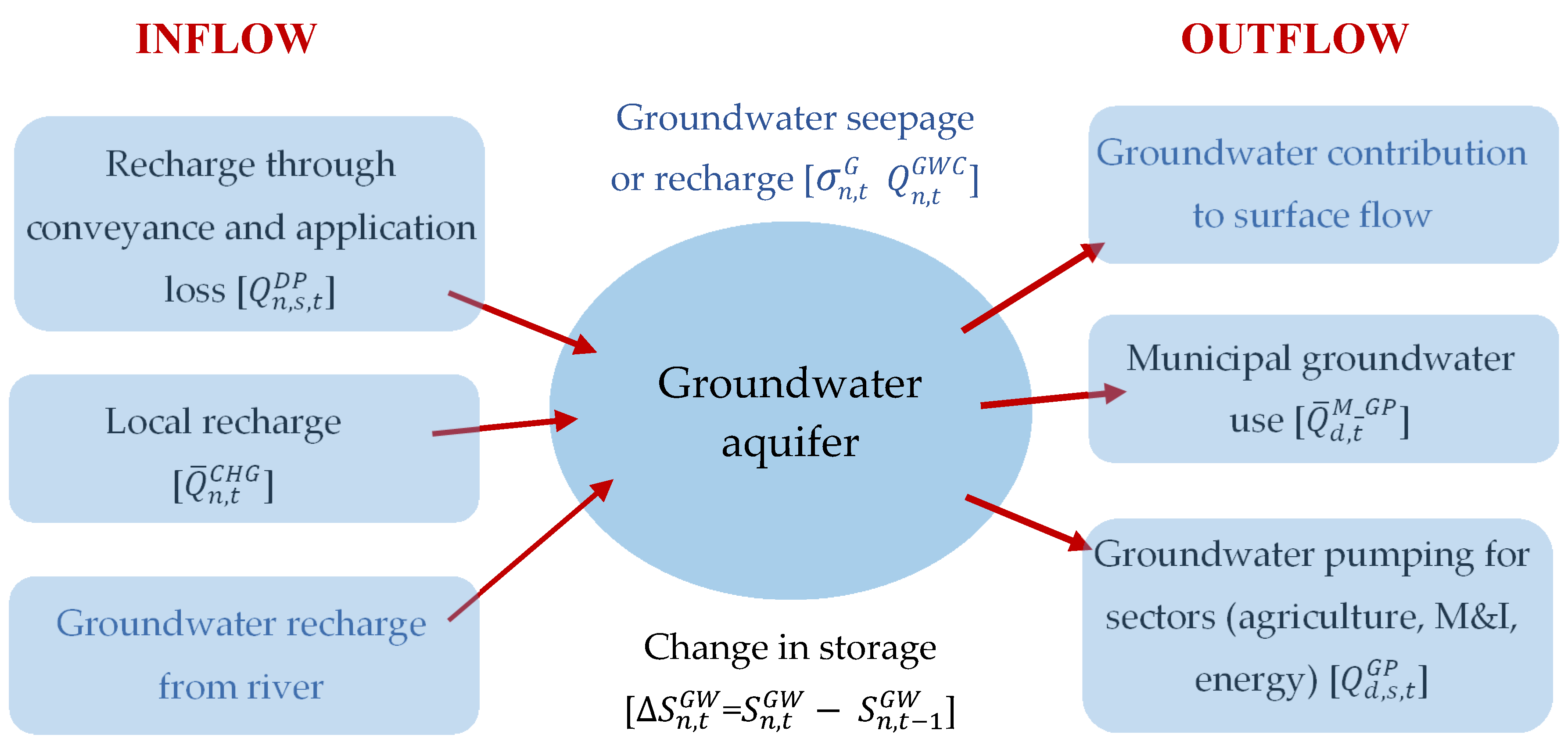
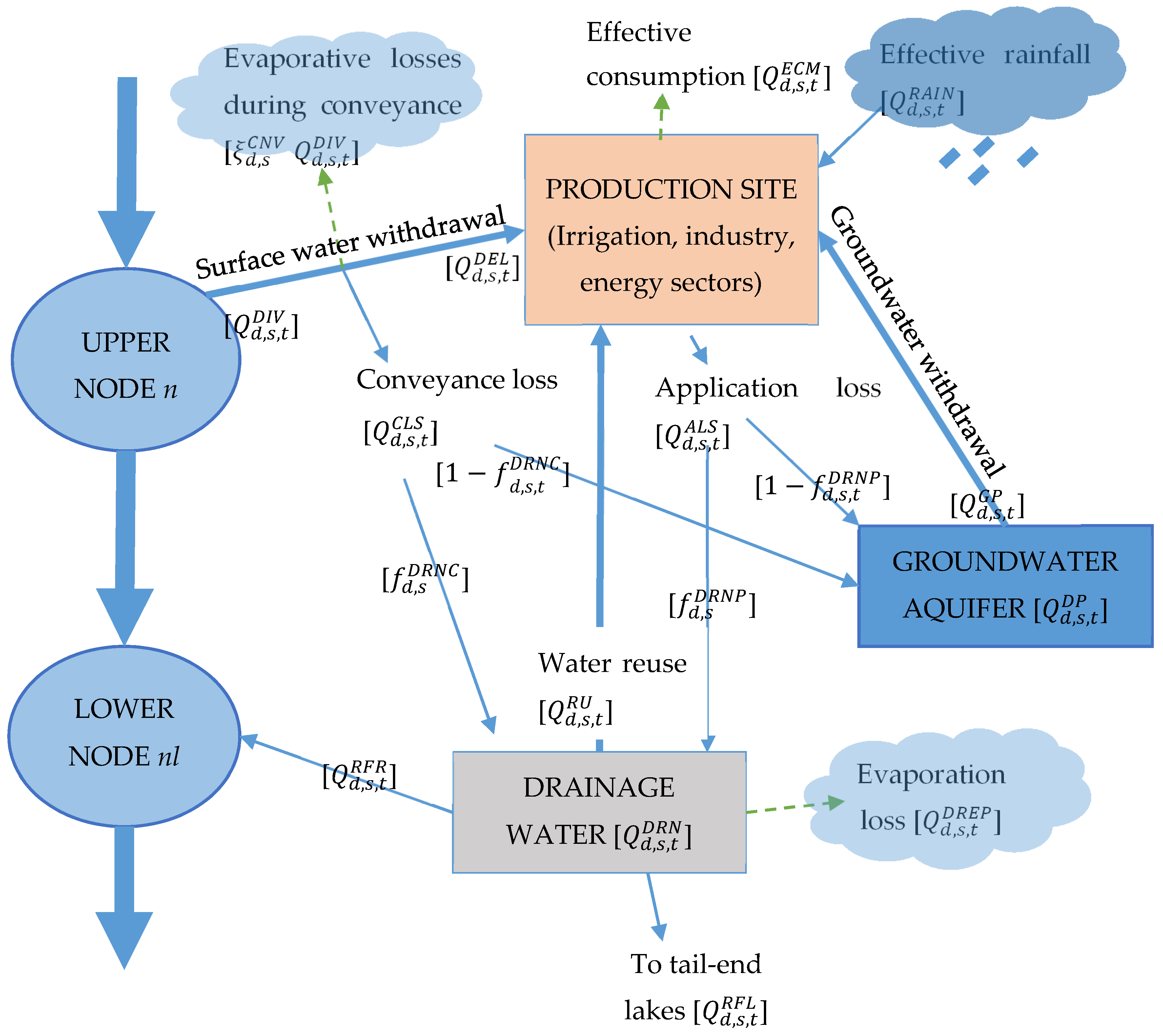
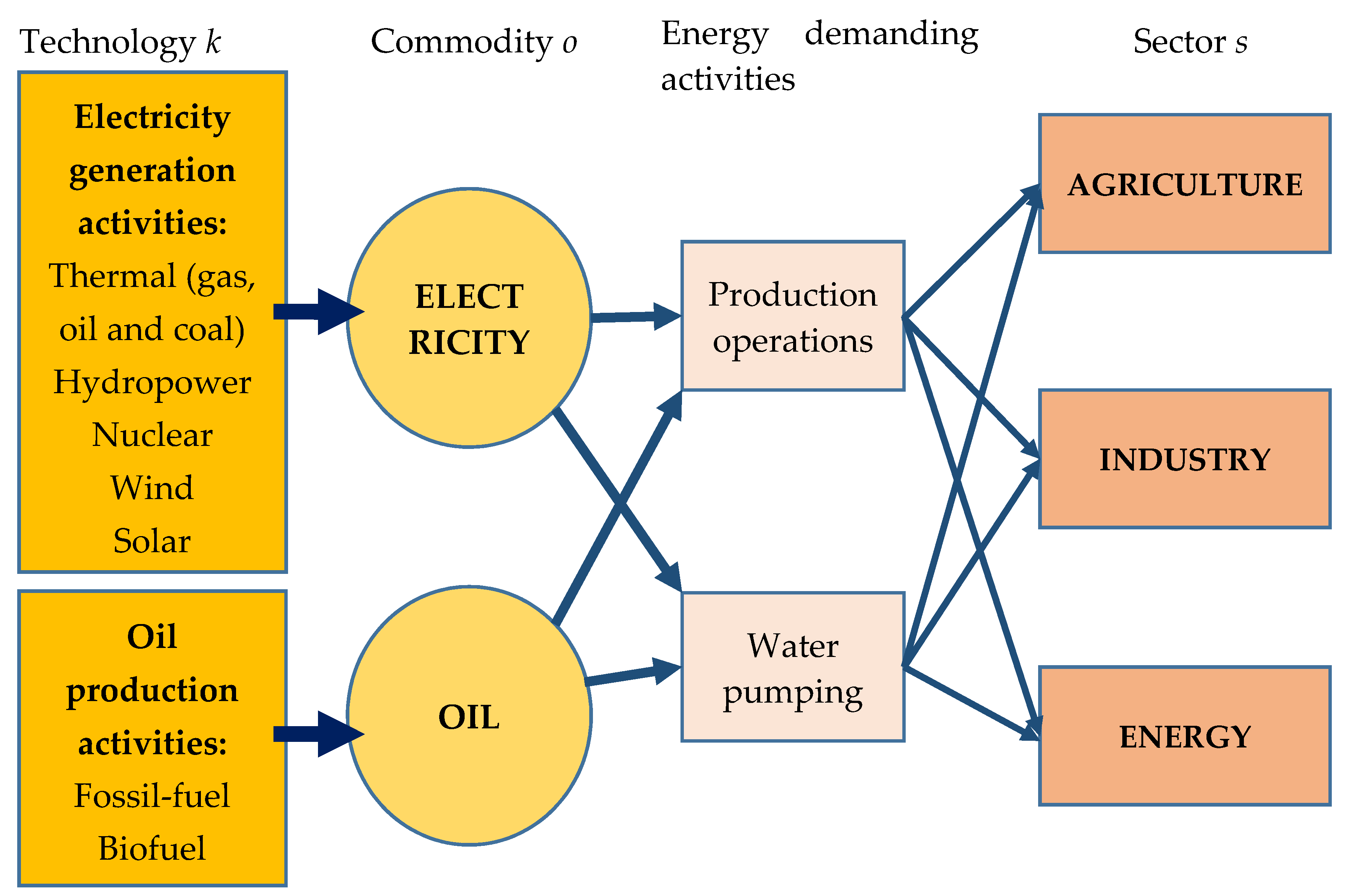
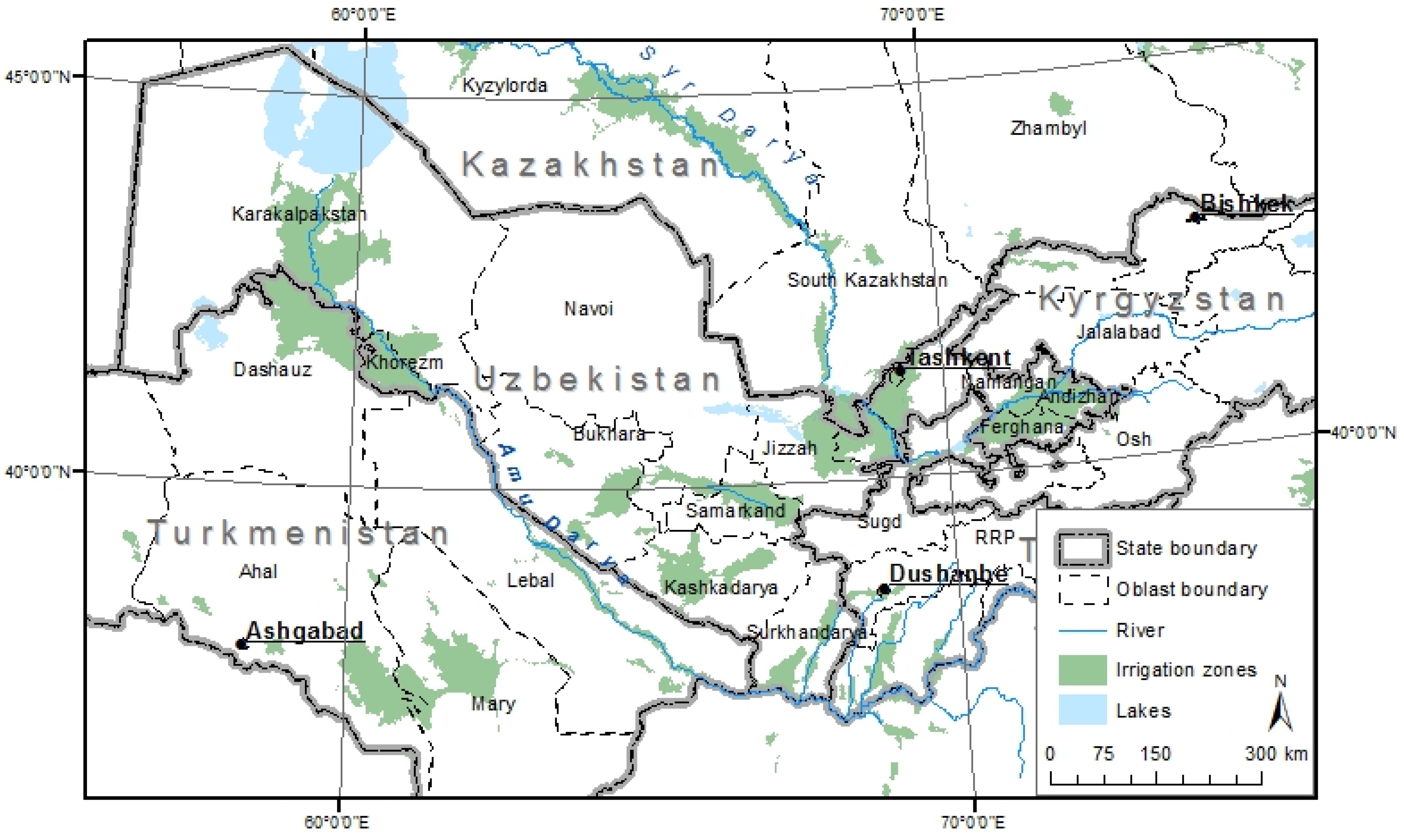
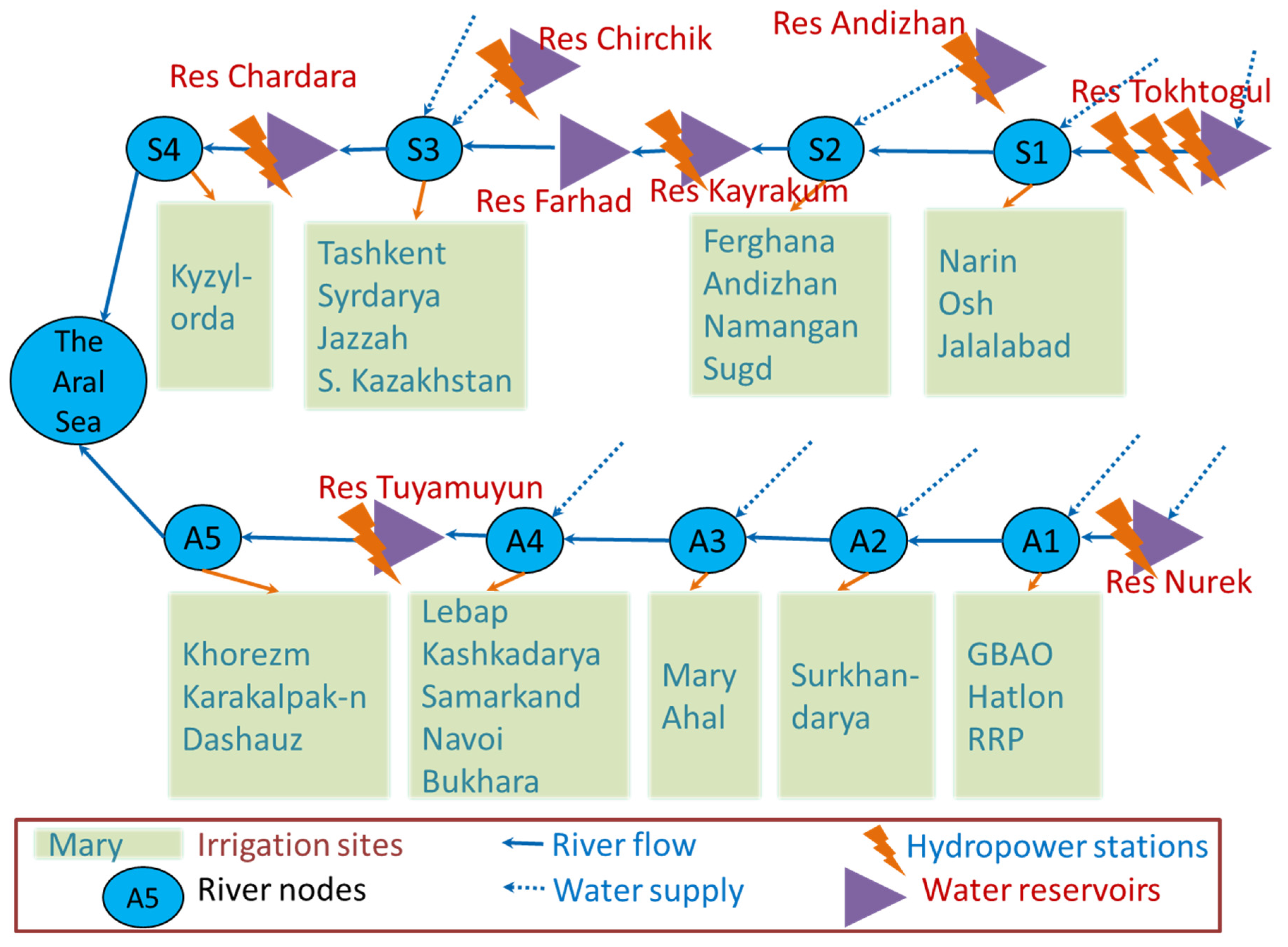
| # | Data Description | Source |
|---|---|---|
| 1 | Water uses by sectors, irrigated land, agricultural yields, agricultural production costs and benefits | SIC-ICWC [53,54], EC-TACIS [55] |
| 2 | Costs for improving water application and conveyance efficiencies | Cai [56], SIC-ICWC [57] |
| 3 | Seasonal crop coefficients for estimating relationships between monthly water uses and crop yield | Cai [56], Schieder [58] |
| 4 | Parameters for depicting the relationships between reservoir head and volume, hydropower production outputs and costs | SIC-ICWC [59], EC-IFAS [60] |
| 5 | Costs, benefits, and development potentials of alternative energy production | CER [61], World Bank [62] |
| Basin | Provinces | Exp1: Without Energy Component | Exp2: With Energy Component | Difference between Exp1 and Exp2 | |||||
|---|---|---|---|---|---|---|---|---|---|
| GW (million m3) | SW (million m3) | GW (million m3) | SW (million m3) | GW (%) | SW (%) | ||||
| Amu Darya | GBAO | 50 | 314 | 19 | 370 | −63 | 18 | ||
| Khatlon | 410 | 1722 | 412 | 1933 | 0 | 12 | |||
| RRP | 0 | 893 | 0 | 893 | n/a | 0 | |||
| Surkhandarya | 292 | 6711 | 292 | 6443 | 0 | −4 | |||
| Mary | 0 | 8730 | 0 | 7559 | n/a | −13 | |||
| Ahal | 0 | 6100 | 0 | 4047 | n/a | −34 | |||
| Lebap | 0 | 5757 | 0 | 5757 | n/a | 0 | |||
| Kashkadarya | 508 | 7836 | 317 | 4729 | −38 | −40 | |||
| Samarkand | 457 | 8594 | 171 | 8946 | −63 | 4 | |||
| Navoi | 131 | 3264 | 49 | 3262 | −62 | 0 | |||
| Bukhara | 199 | 4881 | 199 | 3056 | 0 | −37 | |||
| Khorezm | 0 | 3719 | 0 | 3788 | n/a | 2 | |||
| Karakalpakstan | 0 | 7011 | 0 | 6976 | n/a | 0 | |||
| Dashauz | 0 | 7079 | 0 | 7103 | n/a | 0 | |||
| Syr Darya | Narin | 36 | 286 | 35 | 288 | −1 | 1 | ||
| Osh | 53 | 497 | 50 | 499 | −5 | 0 | |||
| Jalalabad | 39 | 428 | 38 | 428 | −3 | 0 | |||
| Ferghana | 284 | 4390 | 273 | 4408 | −4 | 0 | |||
| Andizhan | 150 | 2874 | 150 | 2874 | 0 | 0 | |||
| Namangan | 251 | 3693 | 224 | 3682 | −11 | 0 | |||
| Sugd | 183 | 1757 | 168 | 1754 | −8 | 0 | |||
| Tashkent | 485 | 4283 | 485 | 4286 | 0 | 0 | |||
| Syrdarya | 159 | 4160 | 135 | 4187 | −15 | 1 | |||
| Jizzah | 176 | 3642 | 182 | 2775 | 3 | −24 | |||
| S.Kazakhstan | 0 | 4351 | 0 | 4542 | n/a | 4 | |||
| Kyzylorda | 0 | 2003 | 0 | 2003 | n/a | 0 | |||
| Total: | 3865 | 104,975 | 3199 | 96,589 | −17 | −8 | |||
| Basin | Provinces | Irrigation Benefits (million USD) | Difference between Exp1 and Exp2 (%) | ||
|---|---|---|---|---|---|
| Exp1: Without Energy Constraints | Exp2: With Energy Constraints | ||||
| Amu Darya | GBAO | 35 | 35 | 1 | |
| Khatlon | 176 | 184 | 4 | ||
| RRP | 59 | 59 | 1 | ||
| Surkhandarya | 126 | 131 | 4 | ||
| Mary | 233 | 219 | −6 | ||
| Ahal | 76 | 66 | −13 | ||
| Lebap | 142 | 143 | 1 | ||
| Kashkadarya | 377 | 341 | −9 | ||
| Samarkand | 198 | 202 | 2 | ||
| Navoi | 47 | 43 | −8 | ||
| Bukhara | 83 | 60 | −28 | ||
| Khorezm | 107 | 106 | −1 | ||
| Karakalpakstan | 190 | 187 | −1 | ||
| Dashauz | 208 | 208 | 0 | ||
| Syr Darya | Narin | 12 | 13 | 6 | |
| Osh | 52 | 53 | 2 | ||
| Jalalabad | 56 | 57 | 2 | ||
| Ferghana | 117 | 121 | 4 | ||
| Andizhan | 162 | 164 | 1 | ||
| Namangan | 161 | 170 | 5 | ||
| Sugd | 80 | 86 | 7 | ||
| Tashkent | 177 | 181 | 2 | ||
| Syrdarya | 174 | 178 | 2 | ||
| Jizzah | 80 | 66 | −17 | ||
| S.Kazakhstan | 177 | 183 | 3 | ||
| Kyzylorda | 73 | 73 | −1 | ||
| Total: | 3378 | 3328 | −1 | ||
| Basin | Provinces | Hydropower Benefits (million USD) | Difference between Exp1 and Exp2 (%) | ||
|---|---|---|---|---|---|
| Exp1: Without Energy Block | Exp2: With Energy Block | ||||
| Amu Darya | Nurek | 183 | 189 | 3 | |
| Tuyamuyun | 7 | 9 | 28 | ||
| Syr Darya | Tokhtogul (KG) | 101 | 99 | -2 | |
| Kurupsay (KG) | 30 | 29 | -2 | ||
| Tashkumir (KG) | 16 | 16 | -2 | ||
| Shamaldisay (KG) | 6 | 5 | -2 | ||
| Uchkurgan (UZ) | 21 | 20 | -2 | ||
| Andizhan (UZ) | 9 | 10 | 12 | ||
| Kayrakum (TJ) | 9 | 9 | 0 | ||
| Farhad (UZ) | 1 | 1 | 1 | ||
| Shardara (KZ) | 5 | 5 | 7 | ||
| Chirchik (UZ) | 28 | 31 | 11 | ||
| Total: | 413 | 422 | 2 | ||
| Drivers of Implementing a Nexus Approach | Challenges for Applying a Nexus Approach |
|---|---|
|
|
© 2016 by the authors; licensee MDPI, Basel, Switzerland. This article is an open access article distributed under the terms and conditions of the Creative Commons Attribution (CC-BY) license (http://creativecommons.org/licenses/by/4.0/).
Share and Cite
Bekchanov, M.; Lamers, J.P.A. The Effect of Energy Constraints on Water Allocation Decisions: The Elaboration and Application of a System-Wide Economic-Water-Energy Model (SEWEM). Water 2016, 8, 253. https://doi.org/10.3390/w8060253
Bekchanov M, Lamers JPA. The Effect of Energy Constraints on Water Allocation Decisions: The Elaboration and Application of a System-Wide Economic-Water-Energy Model (SEWEM). Water. 2016; 8(6):253. https://doi.org/10.3390/w8060253
Chicago/Turabian StyleBekchanov, Maksud, and John P. A. Lamers. 2016. "The Effect of Energy Constraints on Water Allocation Decisions: The Elaboration and Application of a System-Wide Economic-Water-Energy Model (SEWEM)" Water 8, no. 6: 253. https://doi.org/10.3390/w8060253
APA StyleBekchanov, M., & Lamers, J. P. A. (2016). The Effect of Energy Constraints on Water Allocation Decisions: The Elaboration and Application of a System-Wide Economic-Water-Energy Model (SEWEM). Water, 8(6), 253. https://doi.org/10.3390/w8060253





